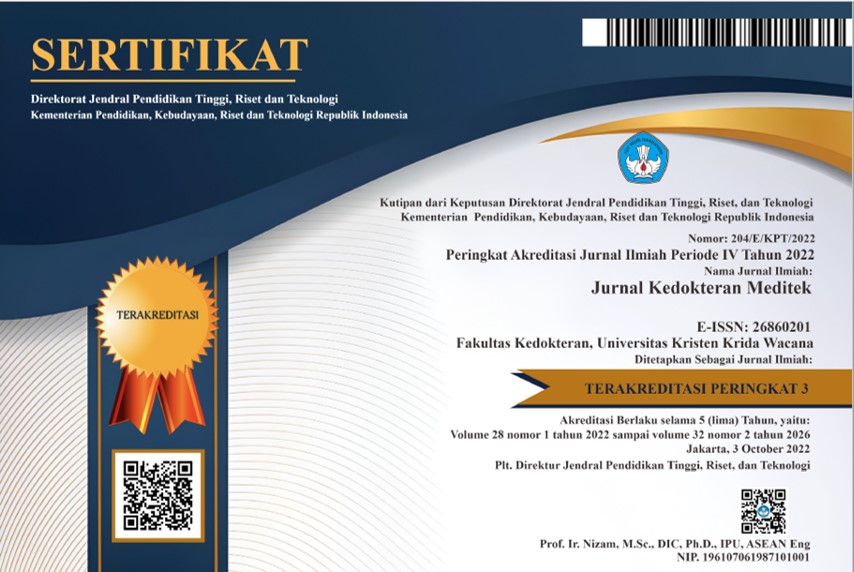Dampak Bangun Lebih Pagi terhadap Irama Sirkadian dan Mengantuk
DOI:
https://doi.org/10.36452/jkdoktmeditek.v28i2.2338Keywords:
bangun lebih pagi, irama sirkadian, mengantuk berlebihan, suhu inti tubuhAbstract
Banyak orang harus bangun lebih pagi sebelum matahari terbit karena tuntutan pekerjaan, sekolah, atau agama. Hal ini kemungkinan akan memengaruhi irama sirkadian. Tujuan penelitian mencari perubahan irama sirkadian pada orang yang bangun dini hari melalui perubahan suhu inti tubuh, dan perubahan proses homeostasis. Metode penelitian analitik pendekatan potong lintang, sampel penelitian 18 mahasiswa FKIK Ukrida angkatan 2016-2019 (21-24 tahun). Dibagi menjadi 2 kelompok, 13 subjek bangun jam 4-5 pagi (kelompok A) dan 5 subjek bangun jam 6-7 pagi (kelompok B). Suhu inti tubuh subjek diukur dengan termometer digital di ketiak setiap jam bangun selama 3 hari berturut-turut. Subjek mengisi kuesioner Epsworth Sleepiness Scale versi bahasa Indonesia. Analisis statistik menggunakan Chi-square. Hasil penelitian pada kelompok A suhu tubuh maksimum tercapai pada jam 18.00, kelompok B jam 19.00. Pada kelompok A circadian dip pada pukul 13.00, kelompok B pukul 15.00. Kelompok A 84,6% mengantuk berlebihan, kelompok B hanya 20% (p=0,022). Hasil penelitian sesuai perkiraan bahwa terjadi perubahan irama sirkadian pada orang yang bangun dini. Simpulan terjadi phase advance 1-2 jam irama sirkadian subjek bangun dini. Jadi sinar matahari tidak cukup kuat untuk entrainment pada subjek yang bangun dini. Selain itu subjek yang bangun dini lebih banyak mengalami mengantuk berlebihan sehingga menggambarkan pengaruh proses homeostasis.
References
Franken P. A role for clock genes in sleep homeostasis. Current Opinion in Neurobiology. 2013;23(5):864–72.
Ashbrook LH, Krystal AD, Fu Y-H, Ptáček LJ. Genetics of the human circadian clock and sleep homeostat. Neuropsychopharmacol. 2020;45(1):45–54.
Zee PC, Attarian H, Videnovic A. Circadian rhythm abnormalities. Continuum (Minneap Minn). 2013 ;19(1):132–47.
Hofstra WA, de Weerd AW. How to assess circadian rhythm in humans: a review of literature. Epilepsy & Behavior. 2008;13(3):438–44.
Mackowiak PA, Wasserman SS, Levine MM. A Critical appraisal of 98.6°F, the upper limit of the normal body temperature, and other legacies of Carl Reinhold August Wunderlich. JAMA. 1992;268(12):1578–80.
BaHammam AS, Sharif MM, Spence DW, Pandi-Perumal SR. Sleep architecture of consolidated and split sleep due to the dawn (Fajr) prayer among muslims and its impact on daytime sleepiness. Ann Thorac Med. 2012;7(1):36–41.
Borsini E, Blanco M, Schonfeld S, Ernst G, Salvado A. Performance of Epworth Sleepiness Scale and tiredness symptom used with simplified diagnostic tests for the identification of sleep apnea. Sleep Sci. 2019;12(4):287–94.
Callaway E, Ledford H. Medicine nobel awarded for work on circadian clocks. Nature. 2017;550(7674):18–18.
Jia Y, Lu Y, Wu K, Lin Q, Shen W, Zhu M, et al. Does night work increase the risk of breast cancer? A systematic review and meta-analysis of epidemiological studies. Cancer Epidemiol. 2013;37(3):197–206.
Morris CJ, Purvis TE, Hu K, Scheer FAJL. Circadian misalignment increases cardiovascular disease risk factors in humans. Proc Natl Acad Sci U S A. 2016;113(10):E1402-1411.
Jagannath A, Peirson SN, Foster RG. Sleep and circadian rhythm disruption in neuropsychiatric illness. Curr Opin Neurobiol. 2013;23(5):888–94.
Zimmet P, Alberti KGMM, Stern N, Bilu C, El-Osta A, Einat H, et al. The circadian syndrome: is the metabolic syndrome and much more! J Intern Med. 2019;286(2):181–91.
Reid KJ. Assessment of circadian rhythms. Neurol Clin. 2019;37(3):505–26.
Duffy JF, Zitting K-M, Chinoy ED. Aging and circadian rhythms. Sleep Med Clin. 2015;10(4):423–34.
Burgess HJ, Park M, Wyatt JK, Fogg LF. Home dim light melatonin onsets with measures of compliance in delayed sleep phase disorder. J Sleep Res. 2016;25(3):314–7.
Videnovic A, Noble C, Reid KJ, Peng J, Turek FW, Marconi A, et al. Circadian melatonin rhythm and excessive daytime sleepiness in parkinson disease. JAMA Neurol. 2014;71(4):463–9.
Waterhouse PJ, Drust B, Weinert D, Edwards B, Gregson W, Atkinson G, et al. The circadian rhythm of core temperature: origin and some implications for exercise performance. Chronobiology International. 2005;22(2):207–25.
Marui S, Misawa A, Tanaka Y, Nagashima K. Assessment of axillary temperature for the evaluation of normal body temperature of healthy young adults at rest in a thermoneutral environment. J Physiol Anthropol. 2017;36(1):18.
Bahammam AS. Sleep from an Islamic perspective. Ann Thorac Med. 2011;6(4):187–92.
Lack LC, Mercer JD, Wright H. Circadian rhythms of early morning awakening insomniacs. Journal of Sleep Research. 1996;5(4):211–9.
Steiger SS, Valcu M, Spoelstra K, Helm B, Wikelski M, Kempenaers B. When the sun never sets: diverse activity rhythms under continuous daylight in free-living arctic-breeding birds. Proc Biol Sci. 2013;280(1764):20131016.
Monk TH. The post-lunch dip in performance. Clin Sports Med. 2005;24(2):e15-23, xi–xii.
Monk TH, Buysse DJ, Reynolds CF, Kupfer DJ. Circadian determinants of the postlunch dip in performance. Chronobiology International. 1996;13(2):123–33.
Deboer T. Sleep homeostasis and the circadian clock: do the circadian pacemaker and the sleep homeostat influence each other’s functioning? Neurobiology of Sleep and Circadian Rhythms. 2018;5:68–77.
Downloads
Published
How to Cite
Issue
Section
License
Copyright (c) 2022 Rimawati Tedjasukmana, Jhordy Christanto Seleng, Steven Sakasasmita

This work is licensed under a Creative Commons Attribution-NonCommercial-ShareAlike 4.0 International License.

















